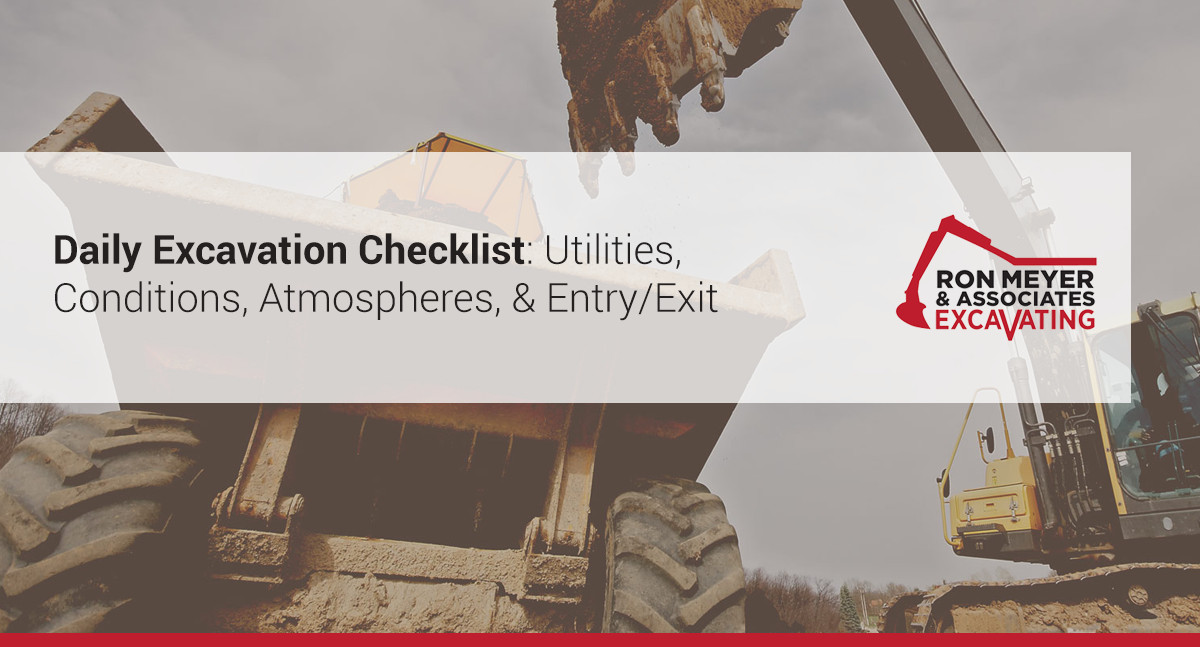
Employers must ensure that a competent person inspects all excavations, adjacent areas, and protective systems daily for possible cave-ins, indications of failures in protective systems and equipment, hazardous atmospheres, and other hazardous conditions. Inspections must be done prior to the start of work and as needed throughout the shift. Inspections are also required after natural events, such as rainstorms, or other hazard-increasing occurrences, such as blasting work. If an inspector finds any unsafe conditions during an inspection, the employer must clear workers from the hazardous area until the necessary safety precautions have been taken. (Source: When must employers conduct excavation site inspections?)
Below is an example daily excavation checklist and the items generally inspected, including utilities, conditions, atmospheres, and entry/exit.
Project Information
- Client/Project Name
- Date
- Time
- Project Location
- Job Number
- Approx. Wind Direction
- Excavation Depth/Width
- Soil Classification
- Protective system used
- Activities in excavation
- Competent person
General
| General | Yes | No | N/A |
| Employees protected from cave-ins & loose rock/soil that could roll into the excavation | |||
| Spoils, materials & equipment set back at least 2 feet from the edge of the excavation | |||
| Engineering designs for sheeting &/or manufacturer’s data on trench box capabilities on site | |||
| Adequate signs posted and barricades provided | |||
| Training (toolbox meeting) conducted w/ employees prior to entering excavation | |||
Utilities
| Utilities | Yes | No | N/A |
| Utility company contacted & given 24 hours’ notice &/or utilities already located & marked | |||
| Overhead lines located, noted and reviewed with the operator – Utility locations reviewed with the operator, & precautions taken to ensure contact does not occur | |||
| Utilities crossing the excavation supported, and protected from falling materials | |||
| Underground installations protected, supported or removed when excavation is open | |||
Wet Conditions
| Wet Conditions | Yes | No | N/A |
| Precautions taken to protect employees from water accumulation (continuous dewatering) | |||
| Surface water or runoff diverted /controlled to prevent accumulation in the excavation | |||
| Inspection made after every rainstorm or other hazard increasing occurrence | |||
Hazardous Atmospheres
| Hazardous Atmospheres | Yes | No | N/A |
| Air in the excavation tested for oxygen deficiency, combustibles, other contaminants | |||
| Ventilation used in atmospheres that are oxygen rich/deficient &/or contains hazardous substances | |||
| Ventilation provided to keep LEL below 10% | |||
| Emergency equipment available where hazardous atmospheres could or do exist | |||
| Safety harness and lifeline used | |||
| Supplied air necessary (if yes, contact safety department) | |||
Entry & Exit
| Entry & Exit | Yes | No | N/A |
| Exit (i.e. ladder, sloped wall) no further than 25 feet from ANY employee | |||
| Ladders secured and extend 3 feet above the edge of the trench | |||
| Wood ramps constructed of uniform material thickness, cleated together at the bottom | |||
| Employees protected from cave-ins when entering or exiting the excavation |
At Ron Meyer & Associate Excavating, Inc, we’ve been providing underground and commercial construction to private and commercial businesses for 39 years. As the general contractor or subcontractor, our experienced foremen, equipment operators, pipe layers, truck drivers and well-maintained equipment fleet make us an undeniable choice for your excavating services. Let’s talk about your project!

As 45 years of experience as an underground/site contactor and a third generation contractor, Ron takes time to go through each individual project with the supervisor and is responsible for all scheduling and equipment logistics. He’s also involved in all troubleshooting for projects.